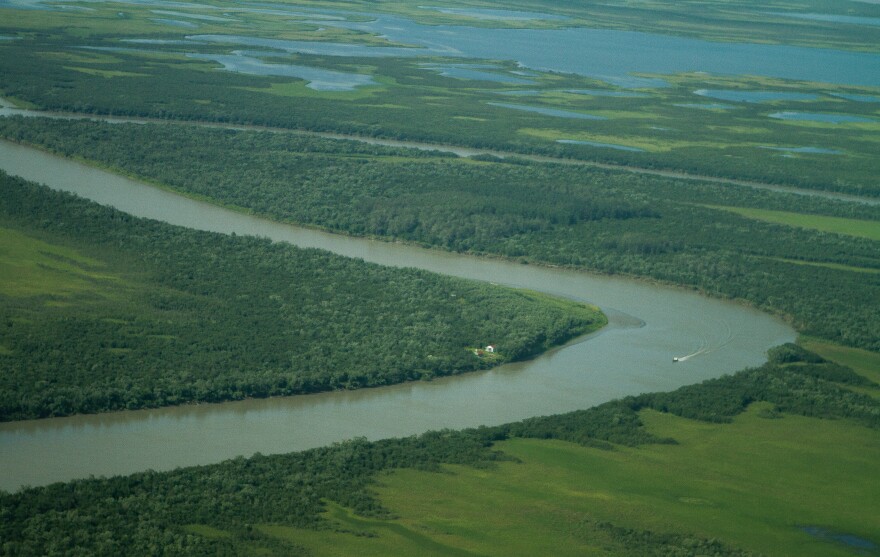This has been the worst salmon fishing season on record for the Yukon River. King salmon, a regional favorite, have returned in low numbers for years, but now a typically stable species, chum salmon, has also collapsed. Subsistence fishing on the lower Yukon River for both species is closed, and residents who usually depend heavily on the fish are pivoting towards other ways to get meat.
“I started fishing on the Yukon when I was six years old. There was one point, me and my grandpa were coming down here for supplies and we had a summer chum jump into the boat. But those days are gone,” said Jason Lamont.
Lamont is from Emmonak and lives off of subsistence food, which in past summers has meant salmon. His family doesn’t buy meat from the store; the salmon caught during the summer will help carry his family through the winter.
“We used to target 300 fish to put away. We’d get that in about two to three hours. Nowadays in our freezer we have only one fish so far, and we’re lucky to have it,” said Lamont.
Elder Herman Hootch also relies on subsistence food. Like Lamont, Hootch is from Emmonak near the Yukon River mouth.
“We learned from our parents that food from the store is not healthy,” said Hootch.
Neither Hootch nor Lamont have been able to subsistence fish for chums or kings on the Yukon this year. Subsistence fishing for the species has been closed all season.

In order for the Alaska Department of Fish and Game to open subsistence fishing, over 500,000 summer chum salmon first need to be counted in the river. Five hundred thousand fish is the lower end of the escapement goal.
Normally that number is met without a problem. On average, the run size is 1.7 million summer chum, as counted by a sonar in Pilot Station. But last year the run suddenly dropped to just 700,000 fish. The number dropped to a fraction of the average run size this year: just 153,497 fish.
Hootch and Lamont are missing a big part of their diet. And to make up for the lost protein, they've gone to some pretty extreme lengths.
“I had to go 100 miles north up just to get my subsistence needs,” said Hootch.
He traveled to the Norton Sound area to harvest chum this summer, but the numbers weren’t great there either. According to a state fishery biologist from the Alaska Department of Fish and Game, chum numbers have been dismal all over the Bering Sea area since last year. She theorized that climate change is responsible for the decline. But since subsistence fishing was at least open in Norton Sound, Hootch made the journey.
“But that first trip I didn't have any luck,” Hootch said.
The second time Hootch did have some luck and caught about 100 chums. He estimates that each round trip cost $500. That means with all the expenses added up, each chum cost him about $10. It was expensive, but cheaper than groceries in Emmonak. And he wasn’t the only one trying his luck there.
“What surprised me this year was the whole delta of the Yukon was up in Norton Sound. We saw hundreds of nets up there. And I said, 'holy cow, that’s the first time that this ever happened,'” said Hootch.

Lamont has also ventured into new waters. He’s been taking his river-going skiff out into the testy waves of the Bering Sea.
“There's a small group of us who are crazy enough to go out there and start harvesting food,” said Lamont.
But they’re not targeting salmon, they’re going for cod and other ocean species and learning in real-time what ocean fishing entails. Lamont said that he takes his boat sometimes as far as 50 miles off the coast. Most boats that go out that far are several times larger than his small skiff.
“And we go out there to the same size ocean, but the storms are the same too,” Lamont said.
But Lamont is determined to not give up on his Yup’ik culture’s subsistence traditions.
“You either gotta adapt, or lose it,” he said.
Three hours upriver by skiff, in the community of St. Mary’s, folks don’t have the same option to travel all the way out to Norton Sound. Instead, they’re supplementing their diet with extra groceries, more whitefish, and they’ll try to bag extra game meat.

At the St. Mary’s boat harbor, Bay and Walky Johnson are on their way out to pick berries. Theirs is one of the only skiffs leaving the harbor that day. The rest of the boats bob along the shore, empty of fishing gear. I ask the couple how they will fill their pantry this winter.
“We’ll go after other species of fish,” said Walky.
“Definitely more moose,” said Bay. “We hope to get fall chum, but I doubt it. Fall chum are good for canning. Also when making more dry fish. But we didn't see any last summer, so I doubt we will see any this summer either,” she added.
The state has no plans to open subsistence fishing for fall chum. That’s because an international treaty governs salmon fishing on the river, and not enough fish will pass through to meet treaty numbers.








